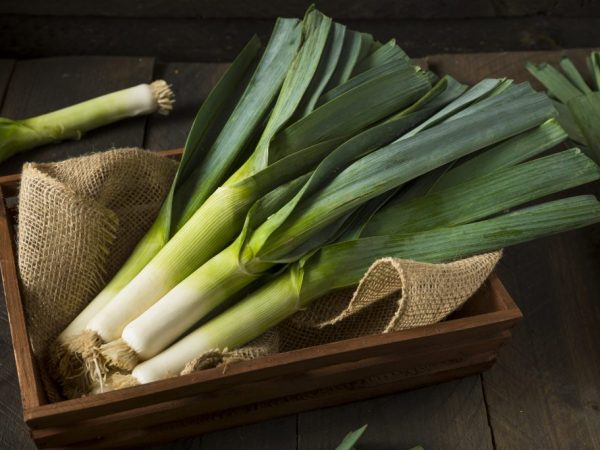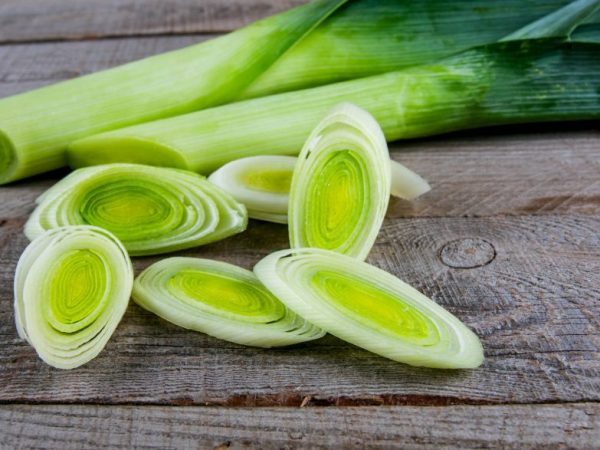How to grow quarantine leeks from seeds
The cultivation of onions on a personal plot is very popular in many countries. Domestic gardeners who grow this useful vitamin vegetable are no exception. If you do not have knowledge of the cultivation and reproduction of this crop, then the yield will be very low or not at all. Many gardeners choose quarantine leeks for growing. This variety is a late ripening type, due to which the growing season of leeks lasts about six months.

Quarantine leek
Description of the variety
The variety tolerates frost well and is suitable for the central and northern regions of Russia. It has a fragrant taste and retains vitamins until late autumn. Growing onions from seeds is not difficult and even a novice gardener can handle it. If you follow all the rules of care, then you can collect a generous crop from one hundred square meters of land, which will weigh about 400 kg.
This variety has a high taste. Due to its very delicate feathers, mouth-watering aroma and light pungency, they try to add it to all vegetable salads. During heat treatment, bitterness is replaced by a sweetish taste. Quarantine onion is very often used for dietary meals or as an independent product, due to its rich vitamin composition and almost complete absence of calories.
Growing methods
There are two ways to grow onions. In order for the onion to take root in your garden and the vegetable to produce a good harvest, you need to adhere to certain rules. For breeding leeks, choose one of two methods: sowing seeds in open ground or planting ready-made seedlings.
Sowing seeds in open ground
Gardeners living in the south or in the very south of the country prefer to grow onions by planting seeds in the open air. This is due to the warmer, more favorable climate and early spring.
For an average climate, where in spring there are often frosts on the ground surface and windy weather, it will be more practical to plant seedlings already grown indoors.
Before sowing seeds, they must first be filled with water, those that float must be removed. The floating seeds will not germinate. And those that have gone to the bottom should be soaked in water just above room temperature, but not more than 50 degrees. Then the seeds are left to swell for 72 hours. This is necessary to activate seed germination. All seeds have a shelf life of no more than three years. After this period, the seeds dry out excessively and lose their qualities necessary for germination.
Sowing seeds for seedlings
Growing quarantine leeks from seeds has certain rules. You need to sow seeds in prepared boxes for seedlings. The soil must be nutritious and moist. Disembarkation is carried out approximately 2 centimeters deep. After the seeds are sown, they need to create greenhouse conditions with a specific microclimate. To do this, the boxes must be covered with plastic wrap on top.Mini greenhouses should be installed in a dark and warm place. Before the first green shoots begin to appear, polyethylene should be opened daily for ventilation.
The most suitable time for sowing seeds is the last days of February, the first days of March, while taking into account the weather conditions in your area.

Good harvest is not so difficult
After about 10-12 days, the first shoots will be visible. This suggests that it is time to remove the film, boxes with seedlings are placed on the windowsill, located on the sunny side. In order not to destroy small seedlings with weak roots, it is worth protecting the seedlings from drafts and hypothermia. Seedlings are watered and sprayed with warm water. To grow strong and well-developed seedlings, dive should be carried out. This process is mandatory and important. Determining the time to pick leeks is very easy. As soon as the thickness of the stem of the sprout has reached 6-7 mm and about four feathers have appeared, you can safely start working. Before diving, in order to avoid damage to the roots, the ground must be watered.
To extract the tender roots of the seedling from the ground, you can adapt a toothpick or something similar. Having picked up a device for extracting seedlings, we transplant them into an additional pot. Do not forget about the fertilization of the Quarantine onion, which is carried out twice a season. When choosing a place for planting leeks, you need to remember that this variety is a very sun-loving plant, so it should grow in the most lighted areas. And it is also not recommended to plant onions in places where garlic, carrots, cucumbers and other varieties of onions were previously grown. But after cabbage, tomatoes, green peas, beans, he will grow comfortably.
Around the ninetieth day after sowing the seeds in the ground, the seedlings can be planted in the open ground. This is about the beginning of summer. Pay attention to the weather. If the night air temperature is still radically different from the daytime air temperature, then the planted seedlings must be covered with plastic wrap until the temperature stabilizes. Immediately before planting, the soil for planting seedlings must be dug up and fertilized. In order for the bush to be large and properly formed, the distance between the rows should not be less than 25 cm. The holes for the seedlings are made about 15 cm deep. The bottom of the hole is covered with wood ash or fertilizers.
Care advice
To achieve a large and high-quality yield of quarantine onions, all plant care requirements should be adhered to. After the onion has been transplanted to a permanent place in open soil, hilling should be done about three times throughout the season. This helps to obtain a larger, whiter stem from the plant. You also need to provide nutrition to the plant. To provide comprehensive nutrition for onions, you need to pour under each seedling in equal amounts:
- Overripe and dry manure
- Straw mulch
- Lightly dried grass
The rest of the time, you need to regularly loosen the soil, remove weeds and water. Leek likes abundant watering, but does not tolerate stagnant water in the soil. It is preferable to water in the morning and in the evening, when the sun's rays are not so scorching. This is done so that the water that will be on the feathers of the onion, during the scorching sun, does not burn them, as this will affect the development of the entire bush. The last bushes need to be harvested in November, before frosts come. In some cases, the quarantine onion is left in the ground for the winter, while taking care that it does not freeze in severe frosts. For this, the following composition is prepared:
- Rotted manure mulch
- Sawdust material
- Dry grass or peat
In the spring, when there is already a thaw, the mulch is pushed aside and the bulbs are watered. Onions that have wintered outdoors are only good for seeds.A two-year-old bush is very different from an annual one. Its feathers are larger in volume and become stiffer. Such an onion is not suitable for a salad. The arrows, on which the seeds will be in the future, begin to appear by the middle of summer. They cannot be broken off before the prescribed time. The seed box should be fully ripe and mature.
Possible diseases
If the onion is properly cared for, it will develop well and delight the gardener with its high-quality harvest. But do not forget about parasites that slow down the growth of the plant. If pest control is not started in time, the plant may simply die. Insufficient watering, as well as waterlogging, leads to fungal diseases.
- Most often, the Quarantine onion suffers from the onion fly. Adults gnaw at the green feathers and lay the larvae, which in turn feed on the white bulb. After this, the death of the plant occurs. Bushes that have suffered from onion flies are destroyed, and the land where the bush was located is processed with tobacco decoction. This is done to prevent the infection from infecting nearby bushes. You can also plant a bed of carrots next door. Onion fly and larvae do not tolerate its smell.
- There is also such a disease as viral mosaic. Such a virus can be distinguished by tiny dots and white striped sections. If you do not take action in time, onion feathers are deformed into an accordion, growth stops and over time the plant simply dies. If the disease has reached the inflorescences on a bush that was left for seeds, it must be destroyed. Since the virus has already managed to infect the planting material.
- You should also be wary of such a fungal disease as cervical rot. This fungus kills leek and garlic crops. It is very difficult to detect this type of disease. For this reason, mostly diseased and healthy seeds are stored together in the same container. The disease can be determined after it can no longer be saved. This can be seen by the decay of the bulb itself, after which the entire bush becomes like mucus. To prevent the disease in the future, before planting seeds in the ground, it is necessary to disinfect the seeds with fungicides.


